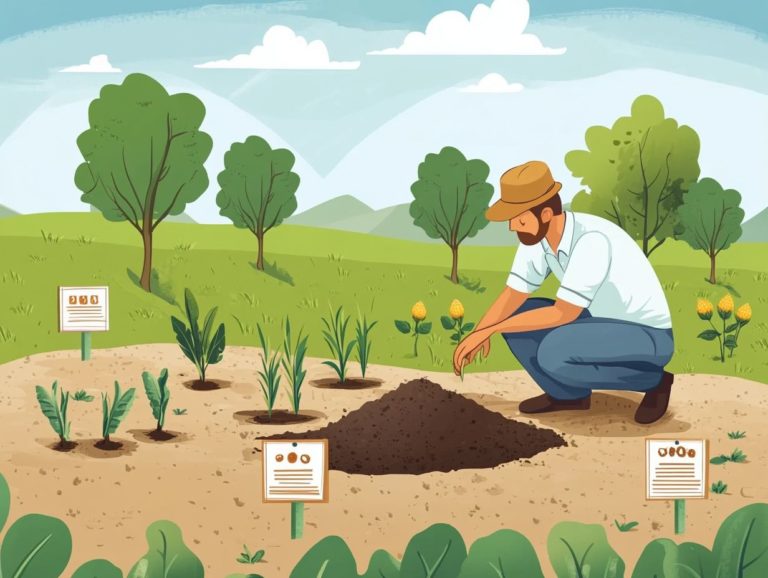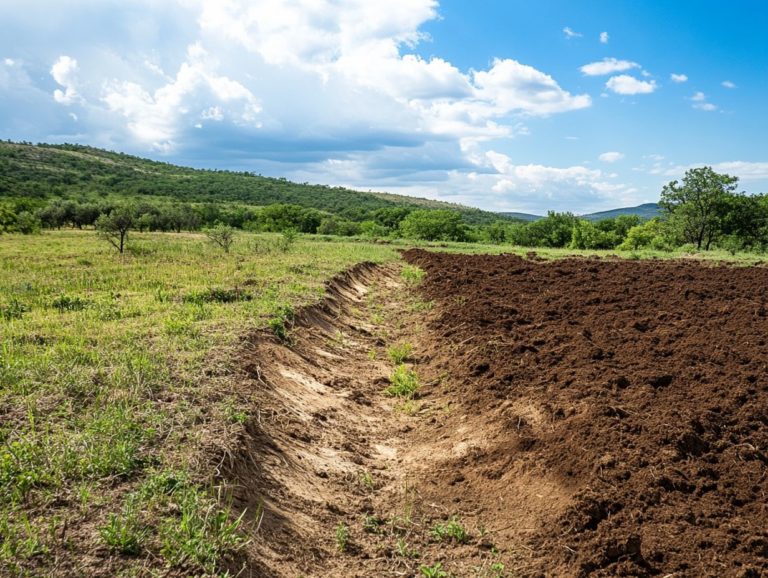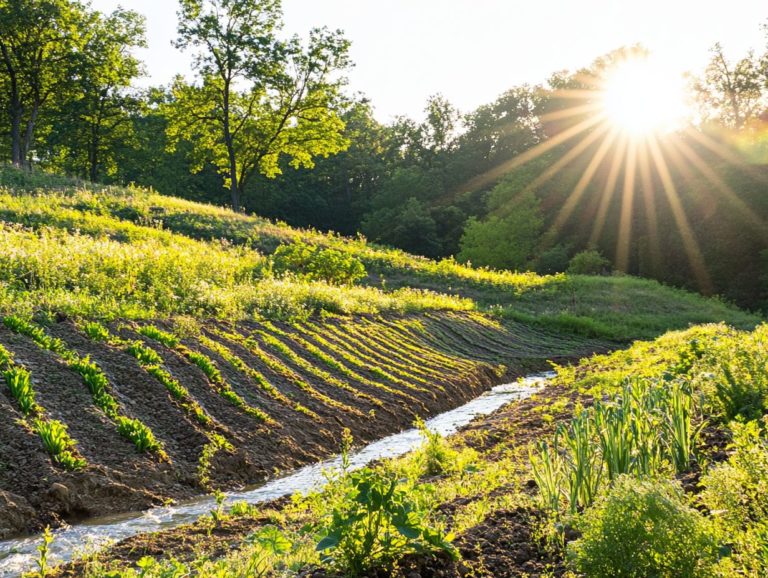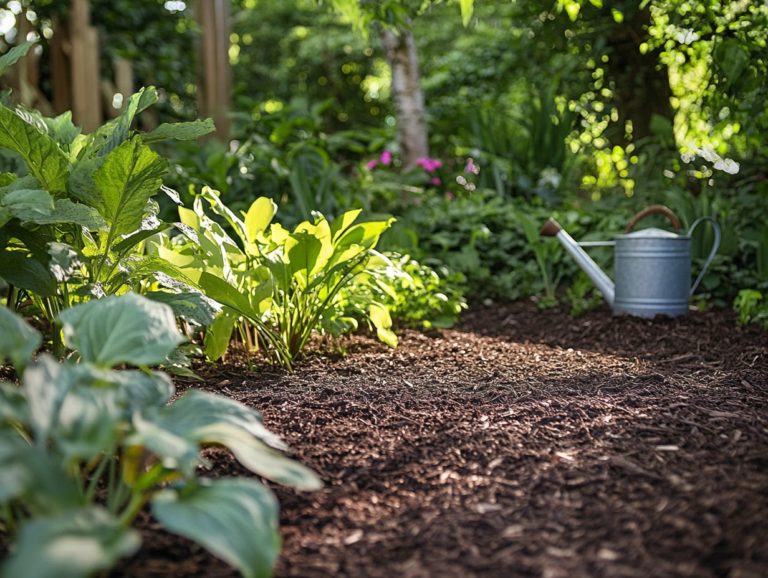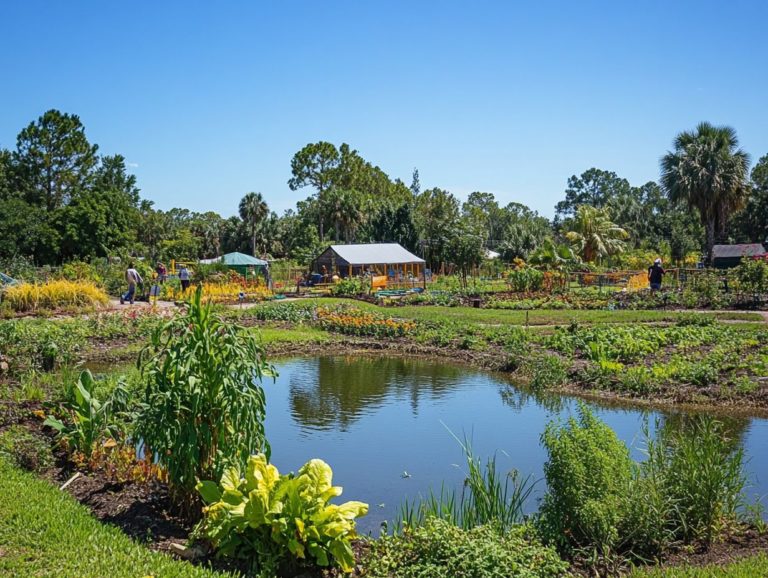Top Cover Crops for Drought-Prone Areas
As drought conditions worsen, farmers are finding creative ways to maintain soil health and conserve water.
Cover crops are proving to be a valuable solution, offering numerous benefits to help adapt to dry landscapes.
This article highlights the top cover crops suited for drought-prone areas and their advantages. You’ll also find tips on integrating these crops into your farming practices.
Discover how these crops can protect your soil and support sustainable farming even in challenging conditions.
Contents
- Key Takeaways:
- 1. Legumes
- 2. Buckwheat
- 3. Sorghum
- 4. Pearl Millet
- 5. Sunn Hemp
- 6. Daikon Radish
- 7. Cowpeas
- 8. Mustard
- 9. Fava Beans
- 10. Sunflowers
- 11. Barley
- 12. Oats
- 13. Rye
- 14. Annual Ryegrass
- 15. Crimson Clover
- What Are Cover Crops and Why Are They Important for Drought-Prone Areas?
- Frequently Asked Questions
- What are cover crops and why are they important for drought-prone areas?
- What are the top cover crops recommended for drought-prone areas?
- How do cover crops help conserve moisture in drought-prone areas?
- What is the best time to plant cover crops in drought-prone areas?
- Can cover crops be used as a source of forage for livestock in drought-prone areas?
- Are there any other benefits of using cover crops in drought-prone areas?
Key Takeaways:
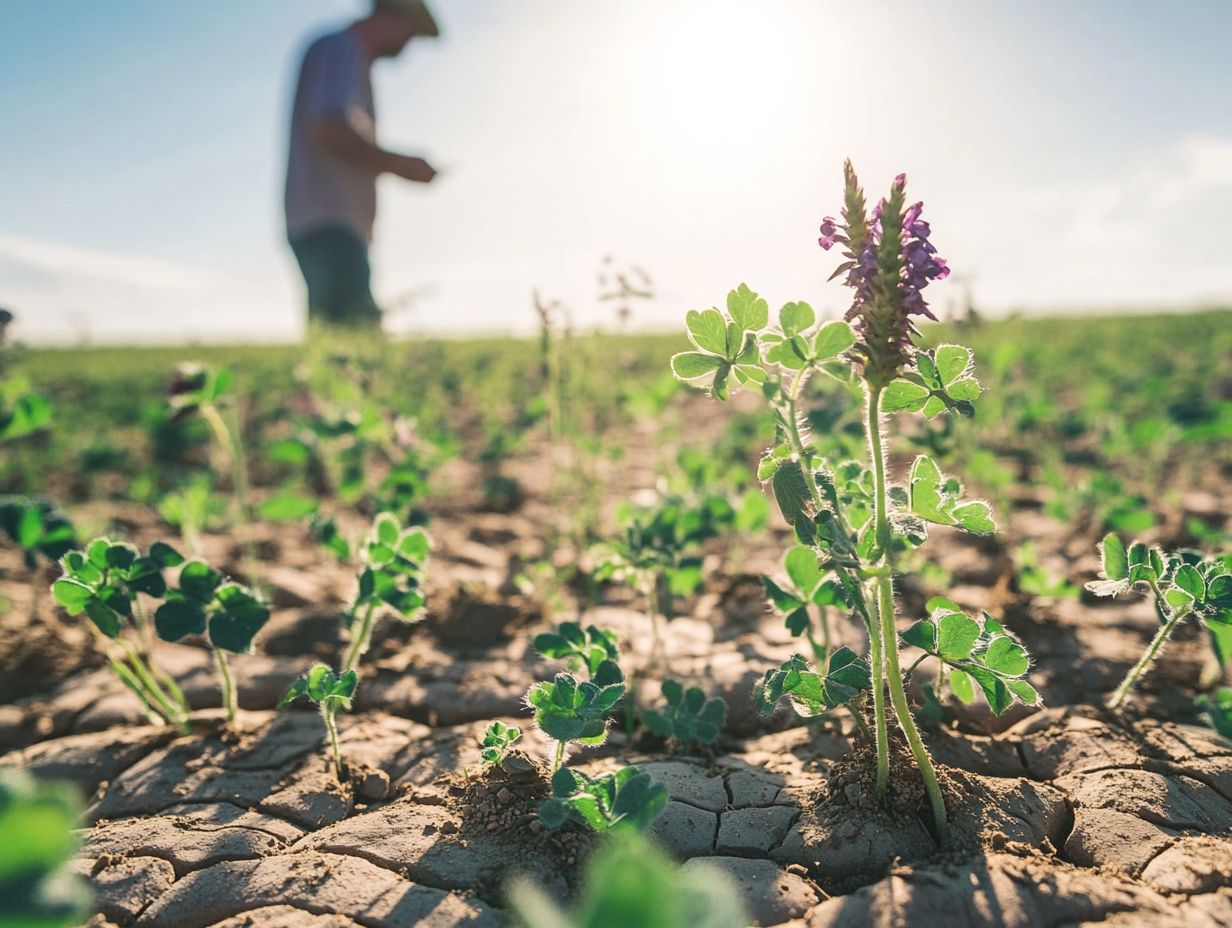
- Legumes are your best friends for drought-prone areas. They fix nitrogen and boost soil health!
- Buckwheat and sorghum help reduce water use and prevent erosion in dry climates.
- Incorporate a mix of cover crops like pearl millet, sunn hemp, and daikon radish to maximize benefits.
1. Legumes
Legumes such as hairy vetch and crimson clover play a crucial role in sustainable agriculture. They enhance soil health by fixing nitrogen, enriching organic matter in various farming regions.
Some legumes, like cowpeas and black-eyed peas, are excellent for nutrient cycling. They break down organic matter, releasing vital nutrients back into the soil, and are crucial for effective crop rotation systems.
Farmers choose different legumes based on local climate and soil conditions. For example, lentils thrive in arid areas, while soybeans complement corn crops in the Midwest, showcasing the adaptability of legumes in building resilient agroecosystems.
2. Buckwheat
Buckwheat is an outstanding cover crop, known for its ability to suppress weeds and control soil erosion. It also fosters biodiversity by providing habitats for beneficial organisms.
This hardy plant matures quickly, in just 10 to 12 weeks, making it ideal for filling gaps in crop rotations. When sown in late summer or early fall, it enhances soil structure and health.
Its deep roots improve moisture retention, while vibrant flowers attract pollinators and predatory insects. This combination boosts soil fertility and nurtures a more resilient agricultural ecosystem.
3. Sorghum
Sorghum stands out as a drought-tolerant cover crop with impressive biomass production. It’s perfect for areas with unpredictable rainfall and works well with the best companion plants for drought areas.
This crop adapts well to various farming systems both conventional and organic. Its deep root system enhances soil structure and nutrient cycling, promoting better soil health.
Planting sorghum in warmer months allows you to maximize the growing season while benefiting from its cover crop advantages, ensuring your soil stays protected and moisture-rich.
Its versatility makes sorghum a superb choice for enhancing biodiversity and crop productivity throughout the seasons.
4. Pearl Millet
Pearl millet stands out as a resilient cover crop, particularly suited for drought-prone areas. Its deep root systems do wonders for soil protection and nutrient management.
By capturing and storing moisture effectively, you ll discover that this versatile crop is a game-changer for maintaining soil hydration levels. It’s especially crucial in regions where water scarcity is a significant challenge.
It also boosts nutrient-rich material, enriching soil health and promoting better nutrient cycling.
When you integrate pearl millet into your crop rotation, it complements your cash crops while breaking disease cycles and promoting biodiversity. This thoughtful planting approach fosters sustainable agricultural practices, making pearl millet an invaluable asset.
5. Sunn Hemp
Sunn hemp is a remarkable cover crop known for its rapid growth and exceptional nitrogen fixation. It enhances soil health and significantly increases organic matter.
This impressive plant not only enriches the soil but also boosts biodiversity, making it an outstanding choice for sustainable agriculture. Its extensive root system captures moisture and prevents soil erosion, benefiting various farming methods.
Sunn hemp also acts as a natural pest management solution. It attracts beneficial insects while repelling harmful pests, reducing reliance on chemical treatments.
6. Daikon Radish
Daikon radish is an exceptional cover crop that alleviates soil compaction. It helps control erosion and enhances nutrient cycling through its deep taproot system.
This root structure breaks up compacted soil, improving aeration. It also enhances moisture retention, especially in dry areas, supporting crop establishment.
As it decomposes, this cover crop adds beneficial organic matter, enriching the soil and boosting microbial activity.
7. Cowpeas
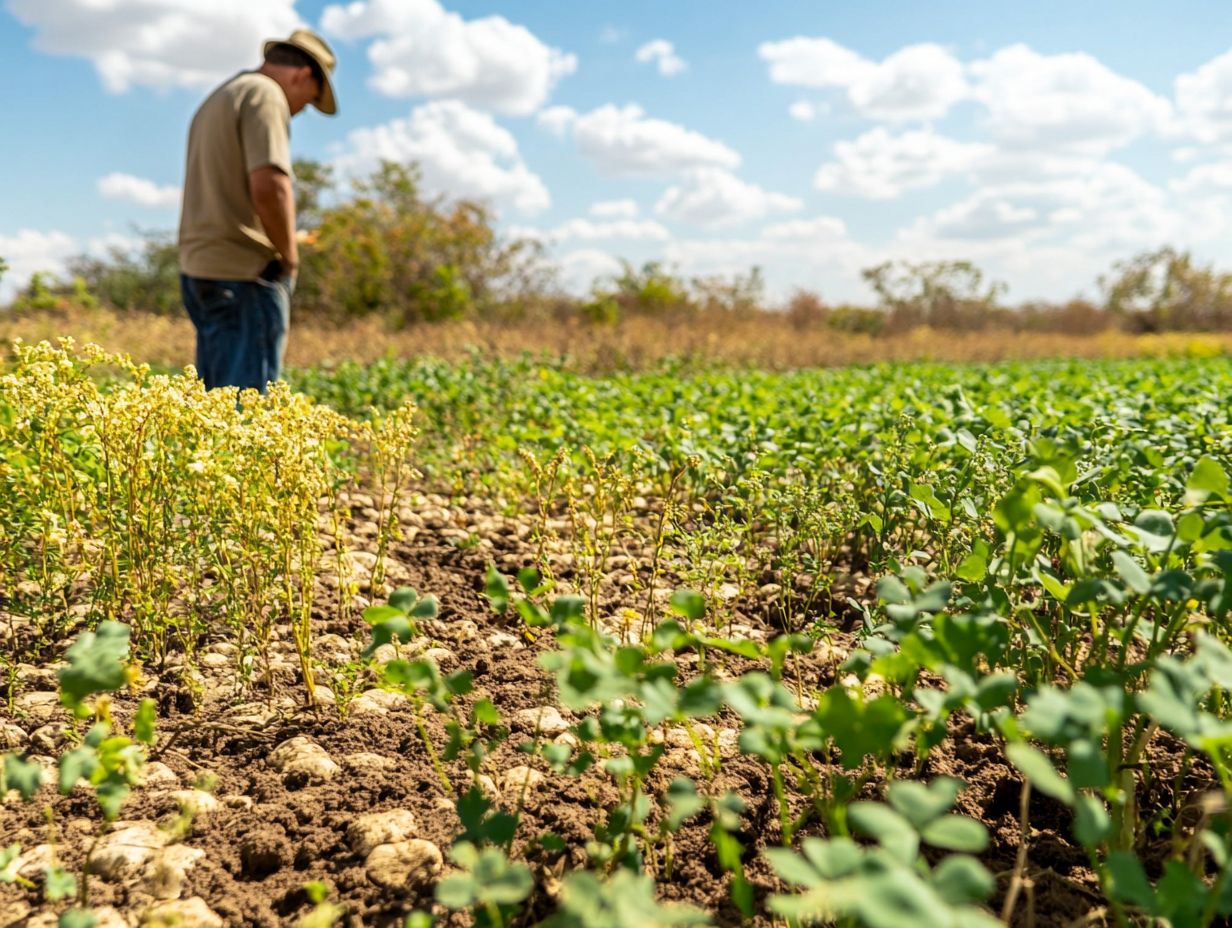
Cowpeas are essential cover crops that enhance soil health through nitrogen fixation. They also foster biodiversity and increase organic matter in your fields.
This remarkable legume thrives in diverse climates, making it ideal for crop rotation. By outcompeting weeds, cowpeas reduce reliance on chemical herbicides.
Integrate them into various farming systems, whether conventional or organic, allowing you to customize your practices.
Their deep roots restore soil fertility, promoting sustainable agriculture and increasing productivity.
Incorporating cowpeas into your farming can lead to healthier soils and more robust crop yields. Start your journey toward greater agricultural success today!
8. Mustard
Mustard is an exceptional cover crop that effectively supports pest management while safeguarding the soil and enhancing its overall health.
Incorporating mustard into your cover crop mixtures not only aids in suppressing harmful nematodes and pests but also plays a significant role in a natural pest control method. By releasing natural compounds, mustard works to diminish soil-borne diseases, fostering a healthier environment for your subsequent crops.
When used strategically, mustard bolsters resilience against pests, acting as a natural deterrent that can reduce your dependence on chemical pesticides. Farmers are increasingly seeing these benefits, making mustard a vital addition to their agricultural practices, promoting sustainability and enriching soil vitality.
9. Fava Beans
Fava beans stand out as a strong cover crop, renowned for their exceptional ability to convert nitrogen in the air into a form plants can use, which significantly enhances soil health and makes a tangible difference in crop production.
These versatile legumes are celebrated not only for enriching the soil with valuable nitrogen but also for their crucial role in boosting overall organic matter. By incorporating fava beans into your crop rotation systems, you can effectively elevate soil fertility and structure, paving the way for subsequent crops to thrive with greater ease.
Their remarkable adaptability to a variety of environmental conditions from the chill of cooler climates to the warmth of more temperate regions ensures that these beans can flourish in diverse settings. This provides you with a sustainable solution for maintaining agricultural productivity while nurturing a vibrant ecosystem.
10. Sunflowers
Sunflowers are not only stunning but essential for your farming success! As a cover crop, they promote biodiversity, assist in weed control, and enhance the productivity of your cash crops.
These vibrant plants have a knack for attracting beneficial organisms, from pollinators to predatory insects, which not only aid in pest control but also enrich the overall health of your ecosystem.
Their deep root systems work wonders for improving soil structure and retaining moisture, making the soil more resilient against drought. This moisture retention is particularly vital in arid conditions, where it can significantly enhance the performance of your subsequent crops, leading to healthier yields.
By fostering these beneficial interactions and ensuring increased water availability, sunflowers become a cornerstone of sustainable agricultural practices, elevating both your farming strategy and the environment.
11. Barley
Barley stands out as an exceptional cover crop that actively supports soil health, provides effective erosion control, and seamlessly integrates with cash crops to elevate agricultural productivity.
This versatile grain thrives across diverse regional climates, whether in dry, arid landscapes or cooler, wetter areas, highlighting its impressive adaptability. With a robust root system that retains moisture and enhances soil structure, barley becomes an ideal choice for those seeking to enrich their land’s fertility.
When rotated with other crops, barley plays a key role in reducing pest pressure and improving nutrient cycling, fostering a more sustainable farming system. Start using barley now to boost your soil health and crop yields!
12. Oats
Oats stand out as a remarkably effective cover crop, celebrated for their prowess in improving soil health, boosting biomass production, and providing crucial erosion control.
These resilient plants flourish in cooler climates, typically finding their place in the ground during early spring or late summer, depending on your region. Their rapid growth isn t just impressive; it actively suppresses weeds and plays a vital role in nutrient cycling by capturing nitrogen and other essential nutrients that might otherwise leach away.
With their ability to retain moisture in the soil, oats help prevent drought conditions while enhancing overall soil structure. For farmers committed to sustainable agricultural practices, oats are truly an invaluable asset, promoting both the fertility and resilience of the land.
13. Rye
Rye stands out as a resilient cover crop that excels in maintaining soil moisture, effectively controlling weeds, and enhancing nutrient management across diverse agricultural settings.
This remarkable plant not only improves soil structure with its deep root system but also enriches biodiversity by nurturing beneficial organisms in the soil. Its adaptability to various regional climates makes it the perfect choice for farmers seeking to adopt sustainable practices, no matter where they are located.
Rye also suppresses pests and diseases, providing an added layer of protection for future crops. This ensures that its benefits extend far beyond just one growing season.
By integrating rye into cover crop mixtures, you can cultivate a more balanced ecosystem that promotes healthier soil. This ultimately leads to improved crop yields and enhances crop establishment.
14. Annual Ryegrass

Annual ryegrass stands as a remarkable cover crop, capable of alleviating soil compaction and enhancing drought tolerance. It significantly boosts biomass production while fostering nutrient density.
Beyond these immediate advantages, this cover crop plays a pivotal role in improving soil structure and increasing nutrient cycling. It makes itself an invaluable asset in a variety of farming systems. You will definitely want to consider incorporating annual ryegrass as a strategic component in your crop rotation practices.
It not only suppresses weeds but also offers a welcoming habitat for beneficial organisms. By fostering healthier soil ecosystems, annual ryegrass paves the way for sustainable agricultural practices that enhance productivity and resilience over time.
This ultimately ensures a more stable environment for your future crops.
15. Crimson Clover
Crimson clover stands as an important cover crop. It enables you to promote nitrogen fixation, enrich soil health, and foster biodiversity within your agricultural practices, making it a valuable addition to your cover crop mixtures.
When you integrate this vibrant legume into your cover crop mixtures, it elevates soil quality. It works seamlessly alongside various grasses and legumes. Planting it in the fall allows it to establish before winter’s chill sets in, maximizing its growth potential.
As spring approaches, you can terminate the clover to release its nutrients, offering a significant boost to your subsequent crops. Its compatibility with species like rye and vetch enhances the overall effectiveness of your mixture.
This ensures a balanced approach to soil management and sustainable farming practices.
What Are Cover Crops and Why Are They Important for Drought-Prone Areas?
Cover crops are important plants for farming that significantly enhance soil health, boost drought resilience, and retain moisture essential qualities in drought-prone regions where crop production faces daunting obstacles.
Typically grown during the off-season between main crops, these plants fulfill a variety of critical roles. They effectively combat soil erosion, suppress pesky weeds, and improve nutrient cycling. All of these contribute to a more robust ecosystem for the crops that follow.
By enhancing soil structure, cover crops promote better water infiltration and retention, which is crucial during dry spells. Their natural ability to fix nitrogen and enrich organic matter gives the power to support sustainable farming practices, enabling you to grow crops with reduced reliance on synthetic fertilizers.
In the long run, incorporating cover crops into your agricultural strategy can bolster resilience against climate variability and foster enduring soil vitality. Start using cover crops today to enhance your soil health and boost your yields!
What Are the Benefits of Using Cover Crops in Drought-Prone Areas?
In drought-prone areas, using cover crops offers many benefits. They provide improved drought tolerance, enhanced nutrient movement, and superior soil health. All these factors contribute to greater crop resilience and support sustainable agriculture.
These amazing plants can transform your soil! They improve soil structure, allowing water to infiltrate and be retained more effectively, even during dry spells. As they grow, they break down and add organic matter, enriching the soil and boosting its ability to hold moisture. With their deep roots, they combat soil erosion and promote biodiversity in the soil ecosystem, creating a healthier environment for your crops.
Together, these advantages support sustainable farming practices better equipped to handle the challenges of climate variability. This ensures long-term agricultural productivity.
How Can Cover Crops Help Conserve Water in Drought-Prone Areas?
Cover crops play a vital role in conserving water, especially in drought-prone areas. They enhance soil moisture retention and reduce evaporation rates, boosting the overall efficiency of farming systems.
These remarkable plants develop intricate root systems that create channels in the soil. This facilitates better water infiltration and minimizes runoff. They also contribute organic matter, improving soil structure and its capacity to retain moisture. For instance, a case study in California revealed that farmers who utilized cover crops experienced up to a 30% increase in soil moisture during dry seasons.
Another successful example from the Midwest showcased how these crops effectively retained precious rainwater. This led to increased yields even under drought conditions. Such practices optimize water usage and advocate for sustainable agricultural methods, ensuring a more resilient farming future.
What Are the Key Considerations When Choosing Cover Crops for Drought-Prone Areas?
When selecting cover crops for drought-prone areas, it’s essential to consider several key factors:
- Soil health
- Compatibility with your cash crops
- Local precipitation levels
- The best planting season
Understanding the specific soil types on your farm can significantly affect how effective your cover crops will be. Different soils retain moisture and nutrients in unique ways. Additionally, existing farming practices are equally important. Take your crop rotation systems and tillage methods into account to ensure the cover crops won t disrupt established protocols.
Aligning your cover crop selections with regional agricultural resources, including climate trends and pest pressures, is vital for developing a sustainable strategy. This approach enhances soil health and bolsters overall farm productivity, especially in the face of drought challenges.
How Can Farmers Incorporate Cover Crops into Their Farming Practices?
You can effectively incorporate cover crops into your farming practices by embracing crop rotation strategies, enhancing soil health, and elevating the sustainability of your agricultural operations.
To achieve this, develop a comprehensive plan that addresses your specific soil needs and the types of crops you currently cultivate. Choosing the right seeds is critical, as different cover crops serve distinct purposes like nitrogen fixation (helping to add nutrients to the soil) or erosion control. Timing is key; planting cover crops at the right moment ensures they establish well before your main crops go in the ground.
By following these practical steps, you can maximize the benefits of cover crops, leading to healthier soils and improved yields.
Frequently Asked Questions
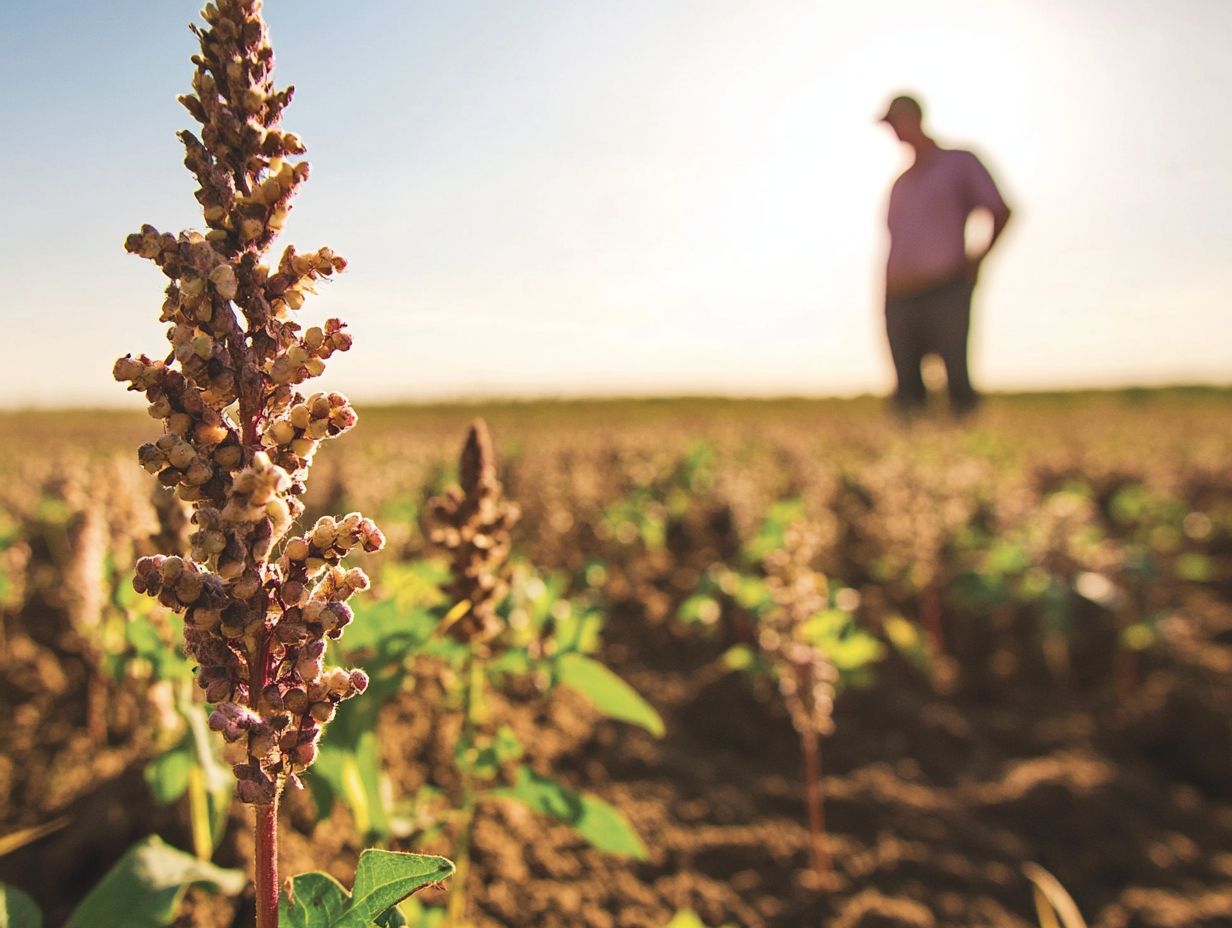
What are cover crops and why are they important for drought-prone areas?
Cover crops are plants grown to protect and improve the soil. They are important for drought-prone areas because they help conserve moisture, prevent erosion, and improve soil health.
What are the top cover crops recommended for drought-prone areas?
Top cover crops for drought-prone areas include legumes like cowpeas and clover. Additionally, using cover crops in drought gardening, such as non-legumes like sorghum-sudangrass and pearl millet, are also effective.
How do cover crops help conserve moisture in drought-prone areas?
Cover crops conserve moisture by shading the soil and reducing evaporation. They improve the soil’s ability to hold onto water.
What is the best time to plant cover crops in drought-prone areas?
Plant cover crops in the fall after harvesting the main crop. This timing allows them to grow before the dry season begins.
Can cover crops be used as a source of forage for livestock in drought-prone areas?
Yes! Cover crops can provide high-quality forage for livestock. Cowpeas and clover are great options, along with sorghum-sudangrass and pearl millet for grazing or hay.
Are there any other benefits of using cover crops in drought-prone areas?
Cover crops offer many benefits. They suppress weeds, attract beneficial insects, and provide habitat for pollinators.
Additionally, they break up compacted soils, improving water infiltration and root growth.


